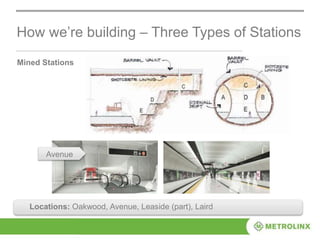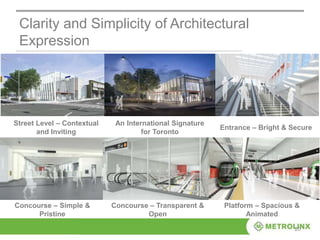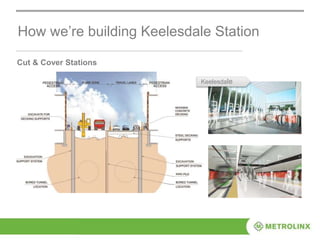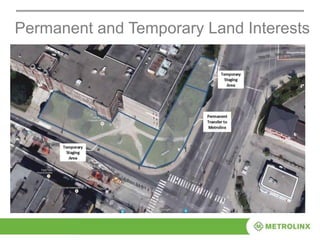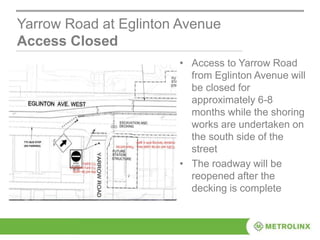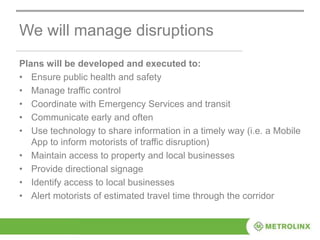Keelesdale station open house
- 1. Keelesdale Station Open House May 4, 2016 EGLINTON CROSSTOWN LRT
- 2. Tackling the Problem The Greater Toronto and Hamilton Area (GTHA) “suffers from traffic congestion problems, poorly integrated transit services and relatively underdeveloped transport infrastructure.” OECD Territorial Review, 2010 • Average commute time per person, per day is 82 minutes. • Projected to increase to 109 minutes in the next 25 years. • Costs $6 billion in travel costs and lost productivity every year. • By 2031, this number could increase to $15 billion. • Over 500,000 tonnes of annual GHG emissions is due to traffic congestion.
- 3. Metrolinx was created in 2006 by the Province of Ontario as the first regional transportation agency for the Greater Toronto and Hamilton Area. We were created to deal with congestion and provide one vision for the region: a transformation vision. Regional Solution 1 Deliver the best possible transportation services today while leading the way to an even better, more convenient service tomorrow. 2 3 Make the best possible use of public transportation investment dollars. Measurably improve quality of life in our region.
- 4. Our Mandate Plan Build Deliver
- 6. We Plan: A Network Vision
- 7. We Build: the regional rapid transit network Two bus rapid transit projects Partially in-service, with remainder under construction: • Viva in York Region • Mississauga Transitway Five new light rail transit lines Under construction: • Eglinton Crosstown In design/planning: • Finch West • Sheppard East • Hurontario-Main • Hamilton Transforming GO train service • More service on all lines • Electric trains, every 15 minutes or better in both directions, for most GO customers Connecting it all together • Expanding and revitalizing Union Station, the heart of the regional network • Deploying PRESTO across the entire TTC
- 8. Union Station Revitalization Improvements: new train shed roof & track replacements Georgetown South Project Improvements: three new tracks along 20kms Bus Rapid Transit New kms: 59 Ridership (2031): 3800+/hour Eglinton Crosstown LRT New kms: 19 Ridership (2031): 5500/hour UP Express Approximately 25 km Ridership: up to 5000/day PRESTO Card Holders: 1,000,000+ Availability: 10 transit agencies Major Projects Completed or Underway
- 9. Safety First – Our #1 Priority • Always have a site specific safety plan and site specific emergency plan. • Ensure pre-work hazard assessments are complete and understood. • Ensure job hazards analyses are complete and understood. • Do everything possible to protect themselves, co-workers, and members of the public. • Stop work if the safety of themselves, co-workers and members of the public cannot be assured. • Identify and report unsafe behaviour and coach each other to make improvements. • Be prepared and equipped to work safely. We train and direct staff to:
- 10. Construction of the Eglinton Crosstown LRT Line Background • In September 2008, Metrolinx launched a regional transportation plan – a 25-year, $50 billion plan -- to coordinate and integrate transportation and transit in the Greater Toronto Area • In 2010, City of Toronto approved the project to build the Eglinton Crosstown from Weston Road in the west to Kennedy Station in the east. • Following a competitive process, Crosslinx Transit Solutions (CTS) was awarded a contract in July 2015 to design, build, finance, and maintain the Eglinton Crosstown Light Rail Transit (LRT). Benefits of P3s: • The Crosstown is being delivered using a public private partnership model called Alternative Financing and Procurement (AFP). • It was procured as one design-build-finance- maintain project to minimize integration risk – historically, a factor for project cost overruns under traditional models. • Under the AFP model, CTS assumes most project risks, including: design, project management and sub- contractor coordination increases in construction material prices and labour costs schedule and project completion delays maintenance and lifecycle replacement of materials within the stations and stops, rails, control systems, and vehicles
- 12. What are we building – a new modern LRT • 15 underground stations and 10 surface stops • A maintenance and storage facility • 19 km of tracks separated from regular traffic • Communications system • Links to 54 bus routes, three subway stations, GO Transit, and a new UP Express station
- 13. 13 Design Excellence Principles & Objectives
- 14. Design Approach: Design from City to Object 14 S i m p l i c i t y I conog ra phy Transparency Ur b a n i t y Simplicity and elegance of the design solution at all scales, from the city to the object; Iconography of the architectural elements to create a unique and highly recognizable signature on Eglinton Avenue, from the slanted portal celebrating kinetic movement, to the profiled wing delineating shelters and waiting areas; Transparency of the entrances and through the station to magnify the presence of natural light, to enact as a way-finding strategy and to uplift the passenger’s experience; Urbanity of the signature layers from landscape to architecture, to underline the genius loci and contextualize the stations and stops within the civic scale of the avenue.
- 15. How we’re building – Three Types of Stations Cut & Cover Stations Chaplin Locations: Keelesdale (Keele), Caledonia, Fairbank (Dufferin), Forest Hill (Bathurst), Chaplin, Mount Pleasant, Leaside (Bayview), Science Centre
- 16. How we’re building – Three Types of Stations Mined Stations Avenue tLocations: Oakwood, Avenue, Leaside (part), Laird
- 17. How we’re building – Three Types of Stations Interchange Stations Eglinton
- 18. • There are four interchange stations. • Interchange stations will allow transit riders to connect to other transit modes, such as TTC, GO and the UP Express How we’re building – Interchange Stations Subway Station Longitudinal Section Locations: Mount Dennis, Cedarvale (Allen), Eglinton (Yonge), Kennedy
- 19. Design Concepts • Passenger First Passenger First Light-filled Stations Simplicity of Circulation
- 20. 20 Clarity and Simplicity of Architectural Expression Street Level – Contextual and Inviting An International Signature for Toronto Entrance – Bright & Secure Concourse – Simple & Pristine Concourse – Transparent & Open Platform – Spacious & Animated
- 21. Crosstown Design Approach Features • About half of the 19 km line is tunneled • Stations and stops are about 0.6 km apart • Features will include: o time arrival information o safe access for people walking and biking to the station o clear route maps, seating, bike parking • Available parking at the start and end of the LRT line. Design Approach • Comply with nine design principles developed by City of Toronto and Metrolinx. • Provide a legacy for generations to come. • Have natural lighting during the day and well-lit entrances at night. • Have safe, clean, intuitive wayfinding at all the stations and stops. • Put passengers first. • Provide visible entrances, bicycle facilities and sustainable practices to ensure all stations comply with Toronto Green Standard Tier. • Landscaped entrances, including planters with trees and ornamental grasses. • Public plazas and retail components at some stations. • Clean and minimalist space at platform level. • Accessible to passengers with disabilities, strollers, and bicycles.
- 22. Construction Overview Distinct phases of construction: • Preparatory works • Utility relocations • Handover of tunnel sections • Support of excavation • Excavation for underground stations • Underground construction of the stations • Track work and systems installation • Traction power system • Signalling system • Testing and commissioning • Road and area restoration
- 23. Preparing for Stations Construction Since fall 2015, CTS has been preparing the line for underground stations and stops construction. Preparatory activities: • Survey and monitor properties for noise and vibrations • Assess soil condition and measure water levels along the corridor • Locate and mark underground utilities • Clearing/grubbing and removing shrubs/trees in the path of the Crosstown • Demolish buildings and other infrastructure (i.e. bridge) • Remove and store street furniture (i.e. benches, bus shelters, planters, garbage bins)
- 24. • The underground stations run between Weston Road in the west to Laird Street in the east. • Construction began at Keelesdale station, located at Keele Street / Trethewey Drive and Eglinton Avenue in March 2016. • Installing support of excavation is the first step in constructing an underground station. • All underground stations will be brand new, including the three LRT interchange stations connecting to other transit modes. • Most of the underground stations will be in construction by the end of 2016. What to expect in 2016 – Start of Stations Construction
- 25. How we’re building Keelesdale Station Keelesdale Cut & Cover Stations
- 26. How we’re building Keelesdale Station Keelesdale Station will be constructed using a cut and cover top-down method. Shoring • Shoring is a common step in the process of installing the foundation of a building. • In the first stage, crews will install steel piles, braces and tie-backs around the sides of the entrances to support the excavation of these buildings to a depth of 20 m. • This will support the surrounding loads until the underground levels of the building are constructed. • This stage will take approximately 14 months. Excavation • The excavation creates a an area of approximately 130 m long x 10 m wide x 10 m tall underneath Eglinton Avenue West. • Within the cavern, the station box is constructed accommodating the rail tunnels, associated platform and rail infrastructure
- 28. Keelesdale Station Aerial View Secondary Entrance Main Entrance Third Entrance
- 29. Keelesdale Station Main Entrance Design
- 30. Keelesdale Station Main Entrance Design
- 31. Keelesdale Station Secondary Entrance Design
- 32. Keelesdale Station Tertiary Entrance Design
- 33. Typical Cross Section View AllenRd
- 34. Keelesdale Station Interior Design
- 35. Keelesdale Station Construction 2016 Look Ahead Decommission existing wells Demolitions Utilities Relocations Support of Excavation/Shoring *at entrances Traffic Staging – Lane reductions commence Early Works - Pre-condition survey - Monitoring instruments - Geotechnical Testing Tree Removals Support of Excavation/Shoring *in Right Of Ways Work Completed
- 36. Keelesdale Station Completed Works Construction crews are preparing the project corridor for further work. A number of activities have been completed or are currently underway. Demolitions: 6 of 6 complete, clean up and backfill underway • Monitoring equipment is being installed at various points inside and outside of the work zones • Median removals on Eglinton Avenue West and Trethewey completed • Traffic lights installation at Eglinton/Trethewey/Keele intersection completed
- 37. Keelesdale Station Construction Zones
- 38. Permanent and Temporary Land Interests
- 39. Keelesdale Station Upcoming Works Utilities • Watermain work in the Eglinton and Keele/Trethewey area starting early May (pending permit) • This work is expected to occur overnight from 10pm-5am Monday to Friday in order to reduce the impact on traffic during the daytime hours • The work is expected to last 10 working days • Traffic: One lane of traffic will be maintained in each direction for the duration of the work • Pedestrians: Sidewalks will be maintained at all times
- 40. Keelesdale Station Upcoming Works Traffic - Stage 1 From spring to fall: • All traffic on Eglinton Avenue moves to the 2 most northern lanes of Eglinton Avenue • All traffic on Keele/Trethewey shifts to the 2 lanes to the east • Approximately 25 parking spaces will be removed along Eglinton Avenue • As construction progresses, traffic impacts will change. Stage 2 will begin in fall 2016 and the new traffic alignment will be communicated
- 41. Staging Plans: spring to fall 2016
- 42. Keelesdale Station Construction Impact Parking Relocation Strategy
- 43. Keelesdale Station Construction Impacts Pedestrians - Stage 1 • Starting in early May, the Eglinton Avenue pedestrian crossing on the west side of Keele Street/Trethewey will be closed • The north west corner sidewalk will be rerouted behind the construction area.
- 44. Keelesdale Station Construction Impacts Pedestrians – Future Impact
- 45. Keelesdale Station Construction Impact TTC Stop Relocations
- 46. Yarrow Road at Eglinton Avenue Access Closed • Access to Yarrow Road from Eglinton Avenue will be closed for approximately 6-8 months while the shoring works are undertaken on the south side of the street • The roadway will be reopened after the decking is complete
- 47. We will manage disruptions Plans will be developed and executed to: • Ensure public health and safety • Manage traffic control • Coordinate with Emergency Services and transit • Communicate early and often • Use technology to share information in a timely way (i.e. a Mobile App to inform motorists of traffic disruption) • Maintain access to property and local businesses • Provide directional signage • Identify access to local businesses • Alert motorists of estimated travel time through the corridor
- 48. Stay in touch 416-782-8118 www.thecrosstown.ca crosstown@metrolinx.com facebook.com/thecrosstown twitter.com/crosstownTO instagram.com/eglinton_crosstown Crosstown West Office 1848 Eglinton Ave W (at Dufferin) Crosstown East Office 660 Eglinton Ave E (at Bayview)
Editor's Notes
- This is what congestion means in terms of lost time, inefficiencies to the region
- Metrolinx was created to deal with this problem and provide one vision for the region: a transformation vision
- Metrolinx does three things: plan, build, deliver (you go into each in the following slides)
- This map shows the existing regional rapid transit network. (click to reveal the 25-year plan)
- we have a 25 year regional transportation plan; this is not a plan that sits on a shelf; this is a plan that delivers real results. This shows the network proposed in the 25-Year Plan of The Big Move Regional Transportation Plan. The Big Move’s vision is an integrated transportation system for the region that enhances prosperity, sustainability and quality of life. It contains close to 100 priority actions and supporting policies with plans for over 1,200 kilometres of rapid transit (more than triple what existed in 2008).
- 8
- These relocations will take place in order to allow for construction and excavation of the future station.















